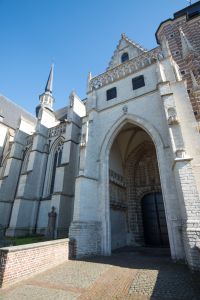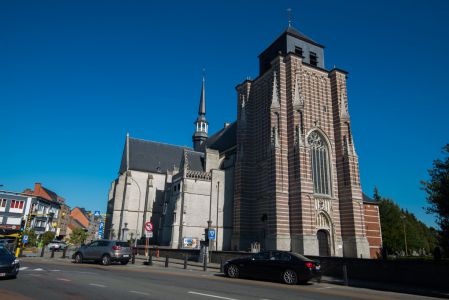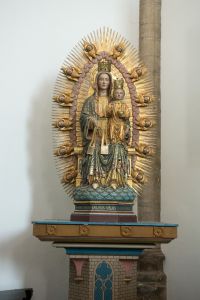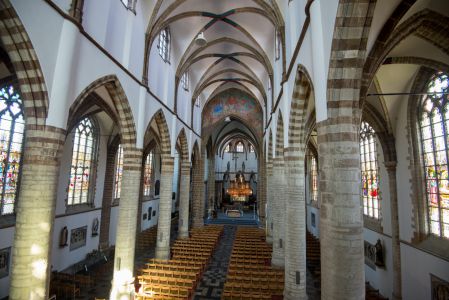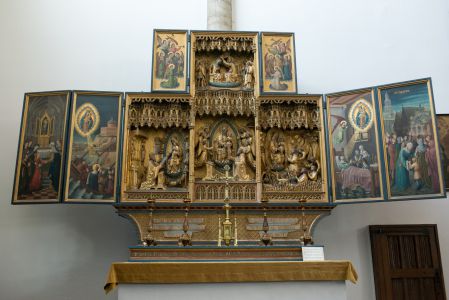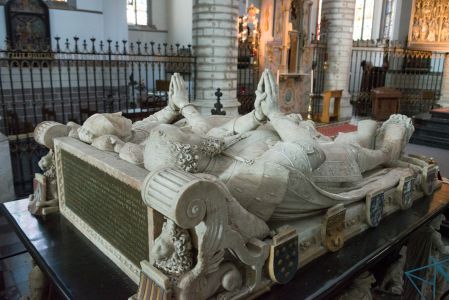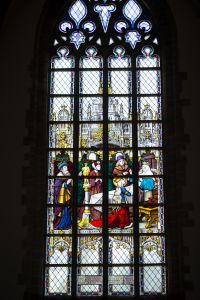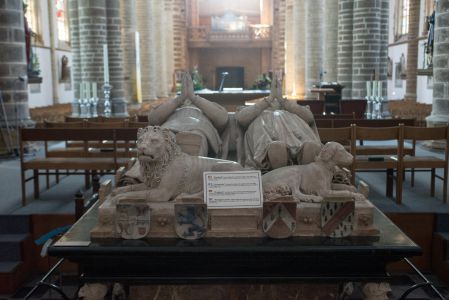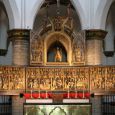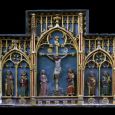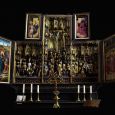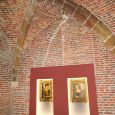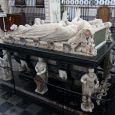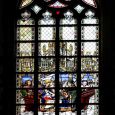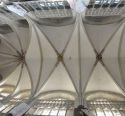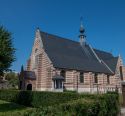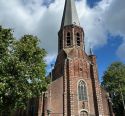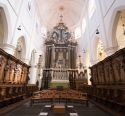Collegiate Church | 1300-1400 | Gothic | Catholic Church


Map
Opening hours
01 April - 30 September
Mon -
Tue 14.00 - 17.00
Wed 14.00 - 17.00
Thu 14.00 - 17.00
Fri 14.00 - 17.00
Sat 14.00 - 17.00
Sun 14.00 - 17.00
Guided tour
Religious offices
Description
The church of Saint Dimpna (1349-1479) is a remarkable building in so-called Demer gothic style. The sturdy, unfinished tower in white limestone and brown iron ore limestone layers was added later (1454-1585).
The church started as a place of pilgrimage where Saint Dimpna and her confessor are said to be buried. Legend has it that Saint Dimpna fled from England to Flanders in the 7th century to escape being married off by her father. He followed her and beheaded her in a fit of madness. The sick and the mentally ill were cured visiting her grave, thus starting the worship of Saint Dimpna. A sick bay was built on the south side of the church in 1683 where mentally ill patients could stay for 9 days while seeking a cure for their condition.
Despite being ravaged during the iconoclasm (1566), the French occupation (end 18th century) and World War II, the church is in good condition and still has a unique interior.
The sober and harmonious interior contains exceptional pieces of art. Most prominent are the altar and the mausoleum of the family de Merode. The altar piece of the apostles was recently added to the list of Flemish top art pieces, as the oldest remaining altar piece in polychrome stone in Flanders. The Dimpna altar piece features since long on this list.
A guide book on the church (64 pages) is available from the tourist office of Geel (3,5 euros). In the church, information panels also offer information on the subject.
Parish Sint-Dimpna
KIKIRPA : Photo-library online
Photos
Media
Remarkable elements
Altarpiece of Saint Dymphne
This altarpiece dates from the 16th century and measures, including Mount Calvary, an impressive 7 m high and 6.5 m wide. It consists of more than 200 oak figurines that form sets or square beds.
It reproduces the legend of Saint Dymphne. The story is constructed horizontally and in three parts. On the lower level, the life and martyrdom of the saint. In the middle is represented the exaltation on earth. The representations on the upper level show the victory of Saint Dymphne in heaven. They are crowned by Mount Calvary.
In a niche is a small neo-Gothic wooden shrine containing the relics and bones of the two martyrs, Saint Dymphne and Saint Gebernus.
Altarpiece of the Apostles
This white stone altarpiece from the second half of the 14th century is probably the oldest work of art in the church. The altarpiece is divided into 7 parts that have the shape of Gothic portals.
The six smaller portals are divided into two niches each in which an apostle with his attributes is presented each time, such as Saint Peter and a key and Saint John the Evangelist with a book. The great portico in the middle contains the Calvary or Christ crucified between the sun and the moon, with Mary and the apostle Saint John on either side.
Altarpiece of the Passion
This oak altarpiece dates from 1490-1500 and comes from a Brussels workshop. This is confirmed by the hallmark of the Brussels sculptors, namely a double hammer, which was found on the back of the scourged Christ during a restoration. The crucified Christ is the center of the composition. When you open the doors, you can "read" the whole story of passion. It reads like a comic strip from Jesus' suffering in the Garden of Olives to Pentecost.
Secret and small paintings of the Merode
In the "secret" or hidden space, relics and works of art as well as important documents were kept. This area once provided access to an upper floor and a cellar. But both were walled up. The "secret" is closed by two 16th century doors.
The complex has recently been restored and converted into a small treasure room. It contains, among other things, two small paintings from the Merode family, painted by Jan Mostaert. The paintings are one and were created during the engagement of the characters depicted. They are both among the most representative works of art in Flemish art.
Funeral monument of Baron Jean III de Merode and Anne de Gistel
The couple married in 1520 and when Baron John III of Merode died in 1550, his wish to be buried next to his deceased wife in the choir of the church of St. Dymphne was fulfilled. This typical Renaissance monument is the work of Cornelis II Floris de Vriendt. It is built according to the ancient tradition.
On a sarcophagus rest the lying statues of the deceased, their hands joined, in an attitude of prayer, eyes open. At the Baron's feet is a lion, a sign of his bravery. At the feet of Anne de Gistel, a lying dog symbolizes family gentleness and fidelity. The tomb bears various coats of arms, which illustrate the possessions of the deceased.
The tomb is supported by Roman figures, heralds, who carry either a flag or coats of arms. Between these characters are some symbols of chivalry: helmet, gloves, sword and laurel wreaths.
Stained glass windows
The stained glass windows in the side naves come from the Antwerp workshop of Stalins and Janssens and date from 1889-1900.
They retrace the life of Saint Dympne. She lived in the 9th century and was the daughter of an Irish pagan king. His mother was a Christian and had had her daughter baptized. After her death, her husband was inconsolable. In a burst of madness, he was convinced that no one could replace his late wife, except perhaps his daughter Dymphne. She refused her father's marriage proposal and fled to Geel, accompanied by her confessor Gebernus. Furiously, the father began to pursue them and killed them both.
The inhabitants of Geel buried the martyrs. After a while, they invoked Dymphne for the healing of all kinds of ailments. Geel became a famous place of pilgrimage, attracting pilgrims from all over the world.
The guard room
A room in the church, hidden and more difficult to access, unknown to many.
In the past, the guard room was the residence of the church guardian and his treasure, an important figure in the functioning of the church. From there, he could watch the whole church.
The statutes of 1585 describe in detail the task of the guardians (or sacristan). He was responsible for the dishes, the order in the church, the sound of the bells that determined the daily rhythm of the inhabitants of Geel and he was present at the services. At dusk, he had to ring the bell to get the lost people on the right track.
This guard room can be visited with a guide, it is not very high, but a centuries-old spiral staircase and a very narrow corridor make it impossible for high heels or people with reduced mobility to visit.
You will also find panels with old photos of the church, showing the destruction of the Second World War and the post-war reconstruction.Sainte Dymphne / Dames de choeur - campagne 2021
Cette jolie femme anglaise se serait, selon la légende, enfuie au 7e siècle et réfugiée en Flandre de peur que son père ne la marie de force. Celui-ci la poursuivit et la décapita dans un moment de folie. Elle est depuis la sainte des malades mentaux.
Partners
Nearby
Heilige Johannes de Doper en O-L-V ten Hemel opgenomen
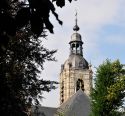
3271 Averbode (Scherpenheuvel-Zichem)
14km
07.00 - 12.30
| 13.30 - 19.00
Open


